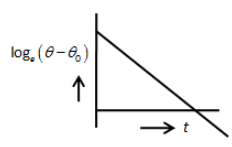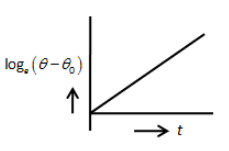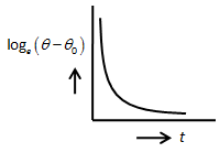
A liquid in a beaker has temperature \[\theta \] at time t and \[{\theta _0}\] is the temperature of surroundings, then according to Newton’s law of cooling, correct graph between \[{\log _e}\left( {\theta - {\theta _0}} \right)\] and t is:
A.

B.

C.

D.





Answer
552.3k+ views
Hint: According to Newton’s law of cooling the rate of heat loss with respect to time is proportional to the difference in the temperature of the body and temperature of the surrounding. Rearrange the expression for Newton’s law of cooling and rearrange it in the required form. Integrate it to get the relationship between \[{\log _e}\left( {\theta - {\theta _0}} \right)\] and time t.
Formula used:
Newton’s law of cooling, \[\dfrac{{d\theta }}{{dt}} = - k\left( {\theta - {\theta _0}} \right)\]
Here, \[k\] is the constant, \[\theta \] is the temperature of the body and \[{\theta _0}\] is the temperature of the surrounding.
Complete step by step answer:
To understand the nature of the graph between \[{\log _e}\left( {\theta - {\theta _0}} \right)\] and t, we have to recall Newton’s law of cooling.According to Newton’s law of cooling the rate of heat loss with respect to time is proportional to the difference in the temperature of the body and temperature of the surrounding. Therefore, we can express Newton’s law of cooling as,
\[\dfrac{{d\theta }}{{dt}} = - k\left( {\theta - {\theta _0}} \right)\]
Here, \[k\] is the constant, \[\theta \] is the temperature of the body and \[{\theta _0}\] is the temperature of the surrounding.
Let’s rearrange the above equation as follows,
\[\dfrac{{d\theta }}{{\theta - {\theta _0}}} = - kdt\]
Integrating the above equation, we get,
\[\int {\dfrac{{d\theta }}{{\theta - {\theta _0}}}} = - k\int {dt} \]
\[ \Rightarrow \int {\dfrac{{d\theta }}{{\theta - {\theta _0}}}} = - kt + C\]
We have, \[\int {\dfrac{1}{x}dx} = {\log _e}x + C\].
Therefore, the above equation becomes,
\[{\log _e}\left( {\theta - {\theta _0}} \right) = - kt + C\]
Thus, we can write,
\[{\log _e}\left( {\theta - {\theta _0}} \right) \propto - t\]
Hence, the graph between \[{\log _e}\left( {\theta - {\theta _0}} \right)\] and t will be the straight-line but with negative slope.If we look at the given options, the option A is straight-line which has negative slope.
So, the correct answer is option A.
Note: While using Newton’s law of cooling formula, \[\dfrac{{d\theta }}{{dt}} = - k\left( {\theta - {\theta _0}} \right)\], make sure that the heat loss is in the form of radiation only and no other source is used to decrease the temperature of the body. Also, the temperature of the surrounding must remain the same throughout the cooling process. The constant of integration C vanishes when you substitute the limits of integration.
Formula used:
Newton’s law of cooling, \[\dfrac{{d\theta }}{{dt}} = - k\left( {\theta - {\theta _0}} \right)\]
Here, \[k\] is the constant, \[\theta \] is the temperature of the body and \[{\theta _0}\] is the temperature of the surrounding.
Complete step by step answer:
To understand the nature of the graph between \[{\log _e}\left( {\theta - {\theta _0}} \right)\] and t, we have to recall Newton’s law of cooling.According to Newton’s law of cooling the rate of heat loss with respect to time is proportional to the difference in the temperature of the body and temperature of the surrounding. Therefore, we can express Newton’s law of cooling as,
\[\dfrac{{d\theta }}{{dt}} = - k\left( {\theta - {\theta _0}} \right)\]
Here, \[k\] is the constant, \[\theta \] is the temperature of the body and \[{\theta _0}\] is the temperature of the surrounding.
Let’s rearrange the above equation as follows,
\[\dfrac{{d\theta }}{{\theta - {\theta _0}}} = - kdt\]
Integrating the above equation, we get,
\[\int {\dfrac{{d\theta }}{{\theta - {\theta _0}}}} = - k\int {dt} \]
\[ \Rightarrow \int {\dfrac{{d\theta }}{{\theta - {\theta _0}}}} = - kt + C\]
We have, \[\int {\dfrac{1}{x}dx} = {\log _e}x + C\].
Therefore, the above equation becomes,
\[{\log _e}\left( {\theta - {\theta _0}} \right) = - kt + C\]
Thus, we can write,
\[{\log _e}\left( {\theta - {\theta _0}} \right) \propto - t\]
Hence, the graph between \[{\log _e}\left( {\theta - {\theta _0}} \right)\] and t will be the straight-line but with negative slope.If we look at the given options, the option A is straight-line which has negative slope.
So, the correct answer is option A.
Note: While using Newton’s law of cooling formula, \[\dfrac{{d\theta }}{{dt}} = - k\left( {\theta - {\theta _0}} \right)\], make sure that the heat loss is in the form of radiation only and no other source is used to decrease the temperature of the body. Also, the temperature of the surrounding must remain the same throughout the cooling process. The constant of integration C vanishes when you substitute the limits of integration.
Recently Updated Pages
Master Class 11 Economics: Engaging Questions & Answers for Success

Master Class 11 English: Engaging Questions & Answers for Success

Master Class 11 Social Science: Engaging Questions & Answers for Success

Master Class 11 Biology: Engaging Questions & Answers for Success

Class 11 Question and Answer - Your Ultimate Solutions Guide

Master Class 11 Business Studies: Engaging Questions & Answers for Success

Trending doubts
What is meant by exothermic and endothermic reactions class 11 chemistry CBSE

10 examples of friction in our daily life

One Metric ton is equal to kg A 10000 B 1000 C 100 class 11 physics CBSE

Difference Between Prokaryotic Cells and Eukaryotic Cells

What are Quantum numbers Explain the quantum number class 11 chemistry CBSE

1 Quintal is equal to a 110 kg b 10 kg c 100kg d 1000 class 11 physics CBSE




